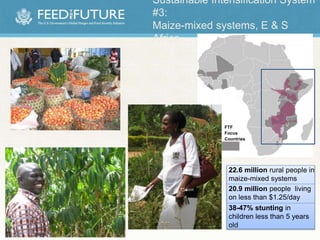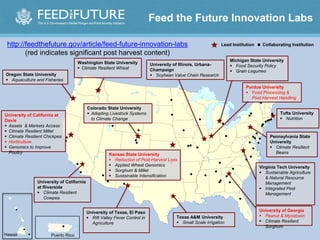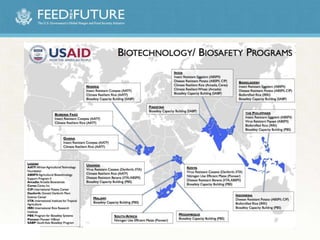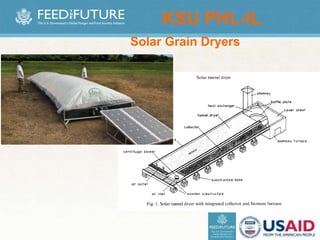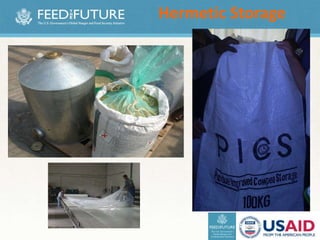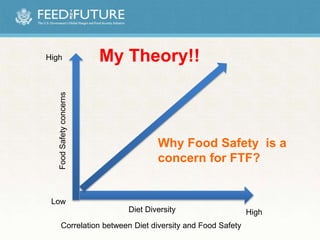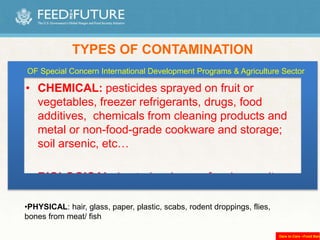Postharvest Loss Reduction & Mycotoxins programs in USAID’s Feed the Future InitiativeUSAID
- 1. Postharvest Loss Reduction & Mycotoxins programs in USAID’s Feed the Future Initiative Ahmed Kablan, Ph.D. International Nutrition & Public Health Adviser USAID /Bureau For Food Security/Office of Agriculture Research and Policy USDA/ARS/Office of International Research Program 1
- 2. 1. “Feed the Future” program 2. FTF ag research agenda 1. USAID postharvest loss & Aflatoxin portfolio 2. Future: Broad Food Safety concerns –looking at mycotoxins and others Presentation Outline
- 3. The Global Challenge By 2050, the world’s population is projected to increase by a third, to more than 9 billion. Most of that increase will occur in the developing world, where hunger is already concentrated Food production will have to increase 70% by 2050 (FAO) if we wish to leave our children a less hungry, more stable world.
- 4. The Global Challenge: Achieving Sustainable Food Security 925 million people – more than a seventh of the world’s population – suffer from chronic hunger. Each year, more than 3.5 million children die from undernutrition.
- 5. 1. Help farmers produce more 2. Help farmers get more food to market 3. Support Research & Development to improve smallholder agriculture in a changing climate 4. Strengthen Regional Trade 5. Create a better Policy Environment 6. Improve Access to What does Feed the Future Do?
- 7. FTF Research “Pillars” 1. Advancing the Productivity Frontier 2. Transforming agricultural systems through “Sustainable Intensification” 3. Improving nutrition and food safety rce: Danforth Plant Sciences Center Source: SM Chapotin
- 8. FTF Focus Countries 8 Sustainable Intensification System #1: Indo-gangetic Plains of South Asia
- 9. 9 Sustainable Intensification System #2: Sudano-sahelien systems in West Africa FTF Focus Countries 19.7 million rural people in cereal root crop mixed and agro-pastoral millet/sorghum systems 10.6 million people living on less than $1.25/day 24-38% stunting in children less than 5 years old
- 10. Sustainable Intensification System #3: Maize-mixed systems, E & S Africa FTF Focus Countries 22.6 million rural people in maize-mixed systems 20.9 million people living on less than $1.25/day 38-47% stunting in children less than 5 years old
- 11. 11 Sustainable Intensification System #4: Ethiopian Highlands FTF Focus Countries 24 million rural people in highland temperate mixed 15.9 million people living on less than $1.25/day 52% stunting in children less than 5 years old
- 12. Basic Translation Utility Applied NSF, USDA, DOE USAI D Arrow of Research and ARP Research Investments 12
- 13. ! ^ ^ • • • • • •• • • •• ••• • • • • • • ★ • • • • • •• •• • • • • •• •• • • • • • •• • • • • • • • • • • • • • • • • ★ ★ ★ ★ ★ ★ ★ ★ ★ ★ ★ ★ ★ ★ Washington State University Climate Resilient Wheat Colorado State University Adapting Livestock Systems to Climate Change Oregon State University Aquaculture and Fisheries University of California at Riverside Climate Resilient Cowpea University of California at Davis Assets & Markets Access Climate Resilient Millet Climate Resilient Chickpea Horticulture Genomics to Improve Poultry University of Illinois, Urbana- Champaign Soybean Value Chain Research Michigan State University Food Security Policy Grain Legumes Tufts University Nutrition Pennsylvania State University Climate Resilient Beans University of Texas, El Paso Rift Valley Fever Control in Agriculture Kansas State University Reduction of Post-Harvest Loss Applied Wheat Genomics Sorghum & Millet Sustainable Intensification Texas A&M University Small Scale Irrigation University of Georgia Peanut & Mycotoxin Climate Resilient Sorghum Virginia Tech University Sustainable Agriculture & Natural Resource Management Integrated Pest Management ★ Lead Institution • Collaborating Institution • Puerto RicoHawaii • • • • • Purdue University Food Processing & Post-Harvest Handling http://feedthefuture.gov/article/feed-future-innovation-labs (red indicates significant post harvest content) Feed the Future Innovation Labs
- 14. CGIAR Network (+ AVRDC, iCIPE, etc…)
- 16. FSIC Program Areas Program for Climate Resilient Cereals (e.g. Cereals RFA, DTMA, Arcadia PPP, Ceres PPP, CGIAR Rice/Wheat/Maize, Sorghum/Millet RFA) Program for Advanced Research on Animal and Plant Diseases (e.g. USDA Partnerships under NBCRI, Virus Resistant Cassava) Program for Productive Legume Research (e.g. Dry Grain Pulse IL, Peanut /Mycotoxin IL, CGIAR Legumes, NBCRI Program for Safe & Nutritious Foods (e.g. PH Labs, Horticulture IL, Nutrition IL, Livestock IL, Aquafish IL, AVRDC, Aflatoxin under NBCRI ) Program for Policy Research & Support (e.g. AMA IL, Program for Biosafety Systems, Enabling Agricultural Trade) Program for Human & Institutional Capacity Development (e.g. MEAS, InnovATE, MAETS, AWARD, LEAP) Program for Sustainable Intensification (e.g. IPM IL, SI IL, CSISA, Africa Rising, Irrigation IL)
- 17. Program for Research on Nutritious and Safe Foods Current Research Projects Activity Manager Lead Institution FTFIL for Horticulture John Bowman University of California, Davis FTFIL for Reduction of Post-Harvest Loss Ahmed Kablan Kansas State University FTFIL for Food Processing and Post-harvest Handling Angela Records Purdue University FTFIL for Livestock Systems (NEW) Elaine Grings University of Florida FTFIL for Nutrition Maura Mack Tufts University FTFIL for Aquaculture & Fisheries Shivaun Leonard Oregon State University World Vegetable Center (AVRDC): Core John Bowman AVRDC World Vegetable Center (AVRDC): Vegetable Post Harvest Handling Project John Bowman AVRDC Golden Rice Joe Huesing IRRI Harvest Plus Vern Long CIAT Collaborative Research in Aquaculture and Horticulture for Improved Nutrition Maura Mack Tufts University CGIAR Research Program – Livestock and Fish Shivaun Leonard International Livestock Research Institute (ILRI) CGIAR Research Program – Nutrition Maura Mack International Food Policy Research Institute (IFPRI) USDA/NBCRI – Aflatoxins Lisa Wilson USDA/ARS The Program for Nutritious and Safe Foods Links research on the production and processing of safe, nutritious agricultural products to a learning agenda on household nutrition, including the utilization and access to fruits, vegetables, meat, fish, dairy and legumes with the goal of improving child survival, securing family investments in agriculture, and preventing and treating under‐nutrition. 17
- 18. PH Training and Service Center, Tanzania • 2012-2014 (UC-Davis and AVRDC) 18 of 42 One-stop shop for equipment, advice, services, and ideas to improve postharvest handling of fresh produce
- 19. AVRDC PH Project – SS Africa and Asia 19 of 42 Adapted local vegetable packing - Tanzania – Understanding vegetable value chains, quantifying current losses and identifying opportunities for intervention Tomatoes awaiting transportation to Dar-es-Salaam, Tanzania Stakeholder workshop, Ghana Interviewing market traders, Kumasi, Ghana Northern Region, Ghana
- 20. AIV Production by HIV farmers AIV processing for export HORT IL, AVRDC, AMPATH, KHCP
- 21. Solar Grain Dryers KSU PHL-IL
- 22. Hermetic Storage
- 23. Purdue FPIL - Incubation Center Model MALI • Northern Mali (Mopti/Gao) – 10 Small- & medium-scale food processors trained – 6 businesses mechanized • Bamako – Incubation Center established – Training local bakeries to produce flour for breadmaking NIGER • 10 Fully functional processors • 2 Recent start-ups • 2 Equipment fabricators • Job opportunities KENYA/SENEGAL • New and improved extruded products (sorghum/millet) • Training processors in Dakar • Equipment fabrication hub
- 24. Key Washington Research Projects ARP: • Peanut/Mycotoxin Innovation Lab • Nutrition Innovation Lab • NBCRI with USDA/ARS • Venganza Research Grant • KSU Post Harvest Innovation Lab • Purdue Food Processing Innovation Lab MPI: • AflaSTOP Post Harvest Storage Structures • AgResults Nigeria pilot project Africa Bureau: • Regional East Africa for Aflasafe USAID Funded Mycotoxin research programs
- 25. Key Field Mission Projects EA Regional: 1) Aflatoxin Policy and Program for East African Region (APPEAR) 2) Aflasafe Utilization in 11 countries (Kenya, Ghana, Nigeria 1st) with IITA and BMGF; 3) Support for EAC Aflatoxin Policy and Action Plan Kenya/Ghana/So. Africa (SPS Capacity Building) Zambia (Maize/Groundnuts: Biocontrol) Mozambique (Maize/Groundnuts: Biocontrol) Rwanda (Maize/Cassava: Biocontrol) Malawi (Maize/Groundnuts – Biocontrol) Tanzania (Maize – Prevalence/Markets) Afghanistan-Mycotoxin Assessment study
- 26. 1. New investments in both research and development assistance 2. Research: grain PH technologies; veg PH technologies; IPM research to decrease pesticide residues and kill storage pests; afla breeding; afla biocontrol; food processing 3. Development: Rwanda PHH Project; warehouse receipts; regional harmonization of afla standards; improved packaging for export 4. Establishing Communities of Practice with FAO, BMGF, State Dept., USDA 5. Sponsorship of international conferences in PH area PH ADVANCES UNDER USAID/FTF (2010-2015 approx. $150M)
- 27. • How Does Food Safety Fit here? • Why is it important to consider?
- 28. An estimated 600 million – almost 1 in 10 people in the world – fall ill after eating contaminated food and 420,000 die every year, resulting in the loss of 33 million healthy life years (DALYs). Children under 5 years of age carry 40% of the foodborne disease burden, with 125 000 deaths (or 30%) every year In Africa, more than 91 million people are estimated to fall ill and 137 000 die each year. Some 60 million children under the age of 5 fall ill and 50 000 die from foodborne diseases in the South- East Asia Region every year.
- 29. Havelaar et al., 2015 Pathogenic sources causes the majority of all FBD
- 30. Causes of FBD 0 5,000,000 10,000,000 15,000,000 20,000,000 25,000,000 Microbes Helminths Aflatoxins Other toxins Burden LMIC zoonoses non zoonoses Havelaar et al., 2015 Is this the real picture or we have evidence/Data gap?
- 31. Nutritional Status Environmental (EE, gut microbiome, environmental toxins) Key factors affecting Nutritional Status
- 33. Diet Diversity FoodSafetyconcerns Low High High Correlation between Diet diversity and Food Safety Why Food Safety is a concern for FTF? My Theory!!
- 34. Food Safety: a multi-faceted issue PHL-IL Nutritio n
- 35. • CHEMICAL: pesticides sprayed on fruit or vegetables, freezer refrigerants, drugs, food additives, chemicals from cleaning products and metal or non-food-grade cookware and storage; soil arsenic, etc… • BIOLOGICAL: bacteria, viruses, fungi, parasites. TYPES OF CONTAMINATION •PHYSICAL: hair, glass, paper, plastic, scabs, rodent droppings, flies, bones from meat/ fish OF Special Concern International Development Programs & Agriculture Sector Dare to Care –Food Bank
- 36. • USAID acknowledges that food safety continues to be a challenge in terms of foodborne diseases, particularly impacting areas/regions where the Agency is supporting development activities as well as programming food aid, and particularly impacting children • USAID has integrated food safety and quality as part of its global nutrition strategy, including acknowledging it's critical relevance during the first 1000 days • USAID embraces a preventive model in food safety, as a more cost-effective and sustainable approach • USAID applies the fundamentals, when it comes to supporting and encouraging food safety and quality practices • USAID acknowledges mycotoxins as a particular relevant challenge in food safety, as well as its link with malnutrition USAID has Established an Agency-wide Food Safety Working Group (BFS/Global Health/DCHA-FFP)
- 37. Please See our Feed the Future Website Thank You! www.feedthefuture.gov









